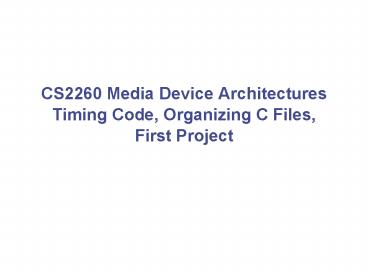CS2260 Media Device Architectures Timing Code, Organizing C Files, First Project - PowerPoint PPT Presentation
1 / 10
Title:
CS2260 Media Device Architectures Timing Code, Organizing C Files, First Project
Description:
One way is to keep track of where the circle is drawn in each page and redraw ... Detour: making a general bitmap Print() routine ... – PowerPoint PPT presentation
Number of Views:31
Avg rating:3.0/5.0
Title: CS2260 Media Device Architectures Timing Code, Organizing C Files, First Project
1
CS2260 Media Device ArchitecturesTiming Code,
Organizing C Files, First Project
2
Revisit assignment 2, 4b
- This is the use pageflipping to move a circle in
mode 5 assignment - Need to erase the circle in each page
- One way is to keep track of where the circle is
drawn in each page and redraw the circle in the
background color - Another way is to clear the whole page by
redrawing every pixel in the background color - A number of you did this you may have noticed
that the circle moves slowly - Lets time how long it takes to clear the screen
3
Timing ClearScreen()
- REG_TM0D 0
- REG_TM1D 0
- REG_TM0CNT TIMER_FREQUENCY_SYSTEM
TIMER_ENABLE - REG_TM1CNT TIMER_OVERFLOW TIMER_ENABLE
- ClearScreen()
- REG_TM0CNT TIMER_ENABLE
- REG_TM1CNT TIMER_ENABLE
- Now how do we print out the timer value?
4
Detour making a general bitmap Print() routine
- Wed like to be able to easily print in bitmap
mode 3, 4 or 5 - The book gives us code for drawing in mode 3
- One approach manually modify the code and copy
and paste it into your program - Better Build a general Print() library that you
can reuse in any bitmap mode program - Need to make the routines work in any bitmap mode
- Need to define a .h file that provides the
defines and function prototypes of your library - Need to tell Ham to use the library
5
Details of modifying Print()
- Work an example in Ham
6
DMA
- Direct memory access (DMA) uses a special piece
of hardware, the DMA controller, to move data
around - The CPU is paused during DMA access
- DMA cant move data faster than the clock rate
- At last two clock cycles per word (16 bit) moved,
usually more because of memory wait states
7
Long story short
- Dont clear the whole screen unless you really
have to - For simple things, like moving a circle or
playing Pong, it is easy to figure out what needs
to be erased, so just erase that - Speaking of Pong
8
First project
- Build a simple racquet ball game
- Bounce a ball against a wall
- Slowly speed up the ball the score is how many
seconds you keep the ball bouncing
9
Issues to think about
- Which graphics mode should we use?
- We want to avoid artifacts
- Dont need a lot of color
- Mode 4 high resolution, have a second page for
artifact-free drawing, enough color (256) - We dont have a paddle controller how can we
make moving a paddle more interesting with button
controls? - Dual speed press A to move faster
- What do we need to draw? How should we draw it?
10
More issues
- How should we count seconds as they go by?
- How should the ball bounce?
- If it hits a stationary paddle or wall
- If it hits a moving paddle
- Angle of incidence angle of reflection
- Perhaps add to the angle of reflection as you
move out from the center of paddle - Perhaps add to the angle of reflection in the
direction of movement if you hit a moving paddle - How should we indicate increasing difficulty?































